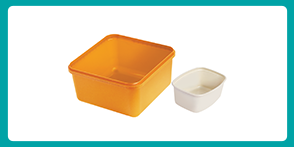Kerbside recycling: plastic trays and containers
What can go into your council kerbside recycling is now the same across Aotearoa. Find out about plastic trays and containers.
What can go into your council kerbside recycling is now the same across Aotearoa. Find out about plastic trays and containers.

Different types of plastics are used to make different types of products. The number tells you what kind of plastic the item is made of.
Number 1 plastics are made from polyethylene terephthalate (PET). PET is typically a clear plastic and often used to make meat trays and biscuit trays.
Number 2 plastics are made from high-density polyethylene (HDPE). HDPE is sometimes used for large containers for vitamins and supplements.
Number 3 plastics are made from polyvinyl chloride (PVC). PVC is used in some biscuit trays.
Number 4 plastics are made from low-density Polyethylene (LDPE). LDPE can be soft and flexible and is used in plastic bags and wrappers. It is difficult to separate and sort so not easily recyclable at kerbside.
Number 5 plastics are made from polypropylene (PP). They are typically tough and rigid and often used for ice cream containers and yoghurt tubs.
Number 6 plastics are made from polystyrene (PS). PS is commonly used for six-pack yoghurts or cream cheese and other dairy products. Expanded polystyrene is a white foam like material used to protect appliances when being transported.
Just because these items can’t be recycled at kerbside doesn’t mean you can’t recycle them.
Check your local council's website to find out if there are any drop-off locations for lids.
Transfer stations and community resource recovery centres may accept hazardous substance containers. Check your local council's website to find out more.
To recycle plastic paint pots see Resene and Dulux paint take-back services.
Drop-off points for clean plant pots and trays are available at many hardware stores, garden centres and nurseries such as Mitre10, Bunnings, Daltons, and Kings Plant Barn.
Expol operates a Household Polystyrene Recycling Programme at selected hardware stores throughout Aotearoa. This is only for the polystyrene packaging used to protect appliances when being transported.
Polystyrene recycling programmes [Expol website]
Soft plastic drop-off points are available across the country.
Check the Soft Plastics Recycling website to find where you can recycle soft plastic in your area.
Some transfer stations and community resource recovery centres accept bulky plastics for recycling.